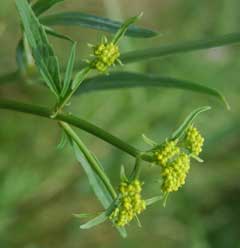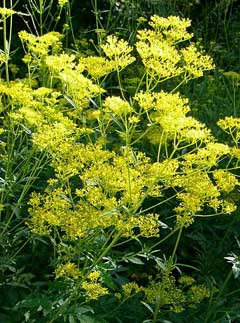 |
|
http://commons.wikimedia.org/wiki/User:Doronenko |
 |
| http://commons.wikimedia.org/wiki/User:KENPEI |
Translate this page:
Summary
Bloom Color: Yellow. Main Bloom Time: Early fall, Late summer, Mid fall. Form: Upright or erect.
Physical Characteristics

 Patrinia is a PERENNIAL growing to 0.6 m (2ft) at a fast rate. It is in flower in August. The species is hermaphrodite (has both male and female organs).
Patrinia is a PERENNIAL growing to 0.6 m (2ft) at a fast rate. It is in flower in August. The species is hermaphrodite (has both male and female organs).
Suitable for: light (sandy) and medium (loamy) soils. Suitable pH: mildly acid, neutral and basic (mildly alkaline) soils. It cannot grow in the shade. It prefers moist soil.
UK Hardiness Map
US Hardiness Map
Synonyms
Plant Habitats
Edible Uses
Young leaves, stem tips and flower buds - cooked and used as a potherb, added to soups or dried for later use[105, 177, 183].
References More on Edible Uses
Medicinal Uses
Plants For A Future can not take any responsibility for any adverse effects from the use of plants. Always seek advice from a professional before using a plant medicinally.
The root is antibacterial, anticoagulant, antiphlogistic, antispasmodic, depurative, diuretic, febrifuge haemostatic and resolvent[147, 174, 178, 218, 279]. It contains several medically active compounds, including triterpenic glycosides and has been shown to stimulate the liver into producing drug-metabolizing enzymes[279]. The root is used in Korea in the treatment of the initial stages of appendicitis, perityphlitis and neuralgia[279]. It is also used in the treatment of parasitic skin diseases and as an antidote to poison[218]. The entire plant is antibacterial, anti-inflammatory and hepatic[176]. It is used traditionally as a sedative[218] and also in the treatment of carbuncles, acute appendicitis, intestinal abscess, postpartum pain, dysmenorrhoea and endometriosis[176]. It stimulates the circulation, treats abscesses, promotes regeneration of liver cells[147, 174, 176, 178]. Large doses can cause a decrease of white blood cells, nausea and dizziness[176]. The crushed leaves are applied to abscesses and boils[147, 218].
References More on Medicinal Uses
The Bookshop: Edible Plant Books
Our Latest books on Perennial Plants For Food Forests and Permaculture Gardens in paperback or digital formats.

Edible Tropical Plants
Food Forest Plants for Hotter Conditions: 250+ Plants For Tropical Food Forests & Permaculture Gardens.
More

Edible Temperate Plants
Plants for Your Food Forest: 500 Plants for Temperate Food Forests & Permaculture Gardens.
More

More Books
PFAF have eight books available in paperback and digital formats. Browse the shop for more information.
Shop Now
Other Uses
References More on Other Uses
Cultivation details
Landscape Uses:Border, Massing, Rock garden. Easily grown in any light rich soil in a sunny position[1, 111]. Special Features:Not North American native, Suitable for cut flowers.
References Carbon Farming Information and Carbon Sequestration Information
Temperature Converter
Type a value in the Celsius field to convert the value to Fahrenheit:
Fahrenheit:
The PFAF Bookshop
Plants For A Future have a number of books available in paperback and digital form. Book titles include Edible Plants, Edible Perennials, Edible Trees,Edible Shrubs, Woodland Gardening, and Temperate Food Forest Plants. Our new book is Food Forest Plants For Hotter Conditions (Tropical and Sub-Tropical).
Shop Now
Plant Propagation
Seed - sow in situ in April[111]. If you only have a small quantity of seed it is probably better to sow it in a pot in a cold frame. When they are large enough to handle, prick the seedlings out into individual pots and plant them out in early summer. Division in spring or autumn.
Other Names
If available other names are mentioned here
Native Range
TEMPERATE ASIA: Mongolia, China (except w.), Korea, Japan (throughout), Taiwan
Weed Potential
Right plant wrong place. We are currently updating this section.
Please note that a plant may be invasive in one area but may not in your area so it’s worth checking.
Conservation Status
IUCN Red List of Threatened Plants Status :

Growth: S = slow M = medium F = fast. Soil: L = light (sandy) M = medium H = heavy (clay). pH: A = acid N = neutral B = basic (alkaline). Shade: F = full shade S = semi-shade N = no shade. Moisture: D = dry M = Moist We = wet Wa = water.
Expert comment
Author
Fisch.
Botanical References
158
Links / References
For a list of references used on this page please go here
Readers comment
| Add a comment |
|
If you have important information about this plant that may help other users please add a comment or link below. Only comments or links that are felt to be directly relevant to a plant will be included. If you think a comment/link or information contained on this page is inaccurate or misleading we would welcome your feedback at [email protected]. If you have questions about a plant please use the Forum on this website as we do not have the resources to answer questions ourselves.
* Please note: the comments by website users are not necessarily those held by PFAF and may give misleading or inaccurate information.
To leave a comment please Register or login here All comments need to be approved so will not appear immediately.
|
|